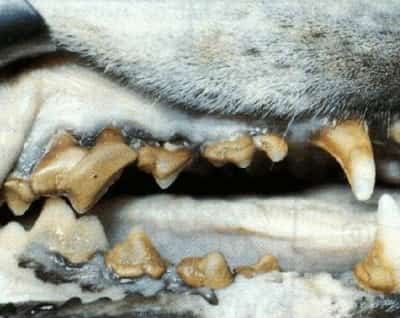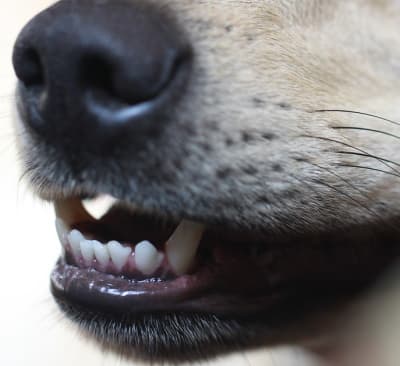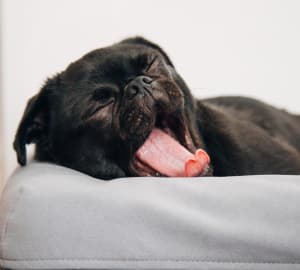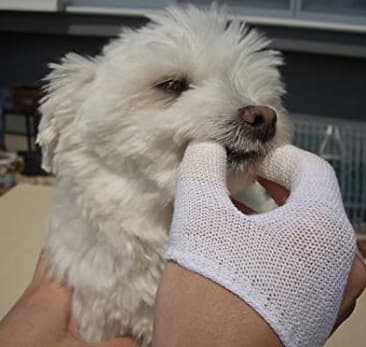Brushing Your Dogs Teeth
Will Keep Him Healthier And More Kissable!
Brushing your dogs teeth may seem a bit daunting at first, but it's really worth the effort in preventing plaque deposits and gum disease which can lead to infections and serious other problems.
Granted it takes dedication and a pet's cooperation to keep up, but if you need a good reason to give it a go, consider this:
Veterinary professionals say that taking care of a dog's teeth
will add five years to his life! Wow!
While there are some innovative products to help keep plaque at bay, the dog tooth brush is
still the number one tool for the job, but I've never seen a dog use one without his owner's help!
Sadly, serious health consequences, as well as painful toothaches for your dog, can result from overlooking this area of dog hygiene. Also, a lot of pets seem to have high pain thresholds so you may never know if he/she is suffering in silence.
The Importance of Brushing
Like many dog
lovers, you may have wondered if you should be brushing your dogs
teeth. The answer is a resounding yes, because just like humans, plaque and tartar accumulates on your pet's
teeth and needs to be removed.
Dental hygiene is so enormously tied to your dog's health and well-being,
that it rates as a "must do" priority.
 Periodontal Disease And Tartar in 2-yr old Dog
image wikimedia.org
Periodontal Disease And Tartar in 2-yr old Dog
image wikimedia.orgRegular use of dental products specially designed for cleaning and brushing your dogs teeth, will not only give your dog a great smile, he will also be healthier as a result!
When To Start Brushing Your Dogs Teeth?
It's never too soon or too late to start brushing your dog's teeth. The ideal time to begin is while he is very young. Regular use
of a pet toothbrush, finger brush, dental chews, water and/or food additives will help a lot to prevent the build-up of plaque and bacteria that leads to gum disease.
It has been reported that dental disease is near the top of the list of health problems
diagnosed by veterinarians.
Not only that, but many other serious canine disorders are started by
oral infections traveling through the blood supply to other parts of the body. So don't delay.
Keeping your dog's teeth in good shape can really help your best friend lead a healthier and longer life. Here are some basics of a preventative dental plan along with the use of effective dental products:

- Start out with a complete dog dental exam to check for any unseen problems.
- Brush your dog's teeth at least three times a week, daily if possible.
- Be alert to changes in condition – bleeding gums, discoloration, chronic bad dog breath or less interest in eating. These are warning signs meaning your dog needs to see his vet.
- Keep your pet on a healthy, natural diet. (See this page for advice).
- Encourage chewing of chew toys and brushing bones specifically designed for dog dental care - under supervision of course.
- Schedule regular pet health and dental check-ups.
Tips For Brushing
Before introducing your pet to a dog tooth brush, gradually get him used to short sessions of
ever-so-gently massaging his gums and teeth with your finger. Start out with some affectionate
petting around his head and when he becomes relaxed all laid back, casually slip your finger in
under his lip.
For a little extra encouragement, you can put some gravy on your finger to get his interest.
 Relaxed
RelaxedWhen he is comfortable with this routine, you can do the same thing with dog toothpaste – don’t worry, this special toothpaste is non-foaming, edible, and no rinsing is necessary.
For what it's worth, my dogs go wild over this toothpaste and actually come running to get a brush!!
I'm sure it's the chicken flavor that gets their attention, but then the enzymes take over and do the rest of the job.
Continuing the process, after a few days, move on to some short sessions with a doggie
finger brush. When your dog is comfortable accepting this, you can try brushing your dogs teeth with a regular dog tooth brush.
Whatever you do, don't give up - just keep practicing and it will work out.
Products For Brushing Your Dogs Teeth
The finger brush is ideal when first starting out with Rover's dental care. It's less invasive than a regular brush and because it's attached to your finger (which sometimes doles out treats!) he'll be more accepting of it. Try it and you'll see.
Later you can try the
double-sided brush. We use both.
Our Favorite Dog Toothpaste Choices
Enzymatic dog toothpastes are frequently recommended by vets as being the most effective in removing bacteria and plaque at the gum line.
"No Brushing" Water Additives For Dogs
When it comes to brushing dog teeth, pet parents generally need all the help they can get. My strategy is to approach a pet's oral hygiene using several dental products to add an extra boost to the brushing routine.
A water additive is a helpful dental aid that I like and it couldn't be simpler to do while filling your pet's water bowl! I keep one inside and one outside to remind me.
While I don't believe water formulas can replace brushing a dog's teeth, they are certainly complimentary to the cleaning process as another layer of protection.
Two very popular water additives are: Oxyfresh and Dental Fresh Advanced
Dental Chews For Dogs
Another great help to augment brushing your dog's teeth are dog dental chews because what dog doesn't like to chew! It's a no brainer.
Just be sure to select the ones most suitable for your dog's chewing style and be sure to oversee this activity the first few times you give him a dog chew just as a precaution.
The chews accepted by VOHC are the ones we give our pets, and by observation, seem to be the most effective.
The dogs seem to like Milk-Bone Brushing Chews the best out of the ones we rotate. They smell awful, but hey, a dog lives by his nose.
"No Brushing" Oral Supplements For Plaque and Tartar
Dental powder supplements, such as Plaque Off, are another level of dental protection for a pet's teeth. I think this one makes a difference when used on a daily basis. It's truly hands off because you just sprinkle it on your dog's food.
Plaque Off works systemically to break down the plaque-causing bacterial film that forms on a dog's teeth and gums. The active ingredient is a special kind of seaweed (human grade) and nothing else.
With all of these dental products at your disposal, brushing dog teeth and getting good results is definitely possible.
While professional cleaning may still be needed on occasion, the interval between vet cleanings will be extended and your dog will thank you for that with a kiss!
Home › Grooming › Teeth Cleaning








